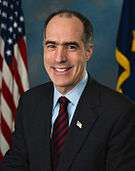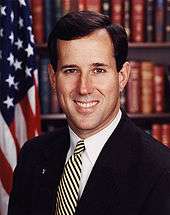United States Senate election in Pennsylvania, 2006
| | |||||||||||||||||||||||
| |||||||||||||||||||||||
| |||||||||||||||||||||||
|
| |||||||||||||||||||||||
| County results | |||||||||||||||||||||||
| |||||||||||||||||||||||
The 2006 United States Senate election in Pennsylvania was held on November 7, 2006. Incumbent Republican U.S. Senator Rick Santorum ran for re-election to a third term, but was defeated by Bob Casey, Jr.[1] Casey was elected to serve between January 3, 2007 and January 3, 2013. Santorum trailed Casey in every public poll taken during the campaign. Casey's margin of victory (nearly 18% of those who voted) was the largest ever for a Democratic Senate nominee in Pennsylvania, and the largest margin of victory for a Senate challenger in the 2006 elections.[2]
Democratic primary
The Democratic primary was held on May 16, 2006.
Candidates
- Bob Casey, Jr., State Treasurer, former State Auditor General and son of former Governor Bob Casey, Sr.[3]
- Chuck Pennacchio, University of the Arts history professor
- Alan Sandals, attorney
Declined
- Barbara Hafer, former State Auditor General and State Treasurer[4]
- Joe Hoeffel, U.S. Representative[5]
Results
Casey won a landslide victory in the primary.[6]
| Party | Candidate | Votes | % | ± | |
|---|---|---|---|---|---|
| Democratic | Bob Casey, Jr. | 629,271 | 84.5% | N/A | |
| Democratic | Chuck Pennacchio | 66,364 | 8.9% | N/A | |
| Democratic | Alan Sandals | 48,113 | 6.5% | N/A | |
| Democratic | Others | 1,114 | 0.1% | N/A | |
| Majority | 115,591 | 68.9% | N/A | ||
| Turnout | 744,862 | +1.3% | |||
Republican primary
John Featherman, who ran against Santorum in 2000 as a Libertarian, had been expected to challenge him in the 2006 Republican primary. However, Featherman withdrew his candidacy after a GOP petition challenge because he did not have the necessary number of signatures to get on the ballot.[9]
Candidates
- Rick Santorum, incumbent U.S. Senator and former U.S. congressman for Pennsylvania's 18th congressional district (1991–1995)
Results
Santorum was unopposed in the Republican primary.
General election
Candidates
Major
- Bob Casey, Jr. (D), State Treasurer
- Rick Santorum (R), incumbent U.S. Senator
Minor
- Carl Romanelli (G)- rail industry consultant, and was removed from the ballot by a Commonwealth Court judge on September 25, 2006 following a challenge from Democrats for failing to collect enough valid signatures required of third-party candidates. He lost the appeal to the state Supreme Court challenging the required number of signatures, on October 3, 2006[10] Carl Romanelli was ordered to pay more than $80,000 in legal fees stemming from his failed effort to make the ballot.[11]
- Kate Michelman (I)- former president of NARAL Pro-Choice America. She decided against running and tacitly endorsed Casey in March 2006[12]
Campaign
Santorum's support for Arlen Specter
Republican strategists took as a bad omen Santorum's primary result in 2006, in which he ran unopposed for the Republican nomination. Republican gubernatorial nominee Lynn Swann, also unopposed, garnered 22,000 more votes statewide than Santorum in the primary, meaning thousands of Republican voters abstained from endorsing Santorum for another Senate term. This may have been partly due to Santorum's support for Arlen Specter, over Congressman Pat Toomey in the 2004 Republican primary for the U.S. Senate. Even though Santorum is only slightly less conservative than Toomey, he joined virtually all of the state and national Republican establishment in supporting the moderate Specter. This led many socially and fiscally conservative Republicans to consider Santorum's support of Specter to be a betrayal of their cause.[13][14][15] However, Santorum says he supported Specter to avoid risking a Toomey loss in the general election, which would prevent President George W. Bush's judicial nominees from getting through the Senate.[16] Santorum says Supreme Court Justice Samuel Alito would not have been confirmed without the help of Specter, who was chairman of the Senate Judiciary Committee at the time.[16]
Santorum's controversial views
In the Senate, Santorum was an outspoken conservative from a state with a history of electing moderates. This led many political commentators to speculate that his low approval ratings were due to some of his more controversial statements and opinions.
Among these controversies were his views on the privatization of Social Security[17][18] and the teaching of intelligent design in public schools.[19] In addition, his involvement in the Terri Schiavo case was considered by many in his state to be out of place.[20][21]
All this left Santorum in a precarious position throughout the race. On May 31, 2006, the polling firm Rasmussen Reports declared that Santorum was the "most vulnerable incumbent" among the Senators running for re-election.[22] SurveyUSA polling taken right before the election showed that Santorum was the least popular of all 100 Senators, with a 38% approval rating and a net approval rating of -19%.[23]
Santorum's residency
While Santorum maintained a small residence in Penn Hills, a township near Pittsburgh, his family primarily lived in a large house in Leesburg, a suburb of Washington, D.C. in Northern Virginia. Santorum faced charges of hypocrisy from critics who noted the similarities between his living situation and that of former Representative Doug Walgren, who Santorum defeated in 1990. Back then, Santorum had claimed that Walgren was out of touch with his district; these claims were backed up with commercials showing Walgren's home in the Virginia suburbs.[24]
On NBC's Meet the Press on September 3, 2006, Santorum admitted that he only spent "maybe a month a year, something like that" at his Pennsylvania residence.[25]
Santorum also drew criticism for enrolling five of his six children in an online "cyber school" in Pennsylvania's Allegheny County (home to Pittsburgh and most of its suburbs), despite the fact that the children lived in Virginia. The Penn Hills School District was billed $73,000 in tuition for the cyber classes.[26]
Casey's momentum
Santorum began his contrast campaign against Casey early, charging him with relentlessly seeking higher political office[27] and failing to take definitive stands on issues.[28] While these charges kept the race competitive, in late September and through October, Casey's campaign seemed to regain the momentum it had had throughout most of the campaign, as most polls showed Casey widening his lead after a summer slump. In a Quinnipiac University Polling Institute poll, released on September 26, 2006, Casey was favored by 14 points.[29] An October 18, 2006 poll conducted by Rasmussen Reports showed Casey with a similar double-digit lead. In the Rasmussen poll, only 46% of voters surveyed had a favorable view of Santorum, while 57% of voters viewed Casey favorably.[30]
Negative advertisements
At least one of Santorum's television ads called into question his campaign's use of the facts regarding Casey and people who had donated money to the Casey campaign.[31] The ad, which aired in September, showed several men seated around a table, while talking amongst themselves and smoking cigars, inside a jail cell. While none of the figures, who were played by actors, were named personally, the narrator provided the job descriptions, previous donations to Casey, and ethical and/or legal troubles of each. The Santorum campaign later provided the names of the people portrayed. An editorial in Casey's hometown newspaper, The Times-Tribune, pointed out that all but one of the contributions "[was] made to Casey campaigns when he was running for other offices, at which time none of the contributors were known to be under investigation for anything."[32] In fact, two of the persons cited in the Santorum campaign ad had actually given contributions to Santorum's 2006 Senate campaign. Another of the figures portrayed had died in 2004. Political scientist Larry Sabato called the ad "over the top" and suspected that the fallout would hurt Santorum.[33]
Polling
| Source | Date | Casey (D) | Santorum (R) |
|---|---|---|---|
| Strategic Vision (R) | November 6, 2006 | 52% | 40% |
| Mason-Dixon/McClatchy-MSNBC | November 5, 2006 | 52% | 39% |
| Muhlenberg/Morning Call | November 3, 2006 | 51% | 43% |
| Reuters/Zogby International | November 2, 2006 | 48% | 40% |
| Keystone | November 1, 2006 | 53% | 38% |
| Quinnipiac | November 1, 2006 | 52% | 42% |
| Temple/Philadelphia Inquirer | October 29, 2006 | 54% | 38% |
| Rasmussen | October 28, 2006 | 55% | 42% |
| West Chester University | October 27, 2006 | 50% | 39% |
| Rasmussen | October 16, 2006 | 55% | 43% |
| Muhlenberg/Morning Call | October 8, 2006 | 46% | 41% |
| Zogby International/Reuters | October 5, 2006 | 48% | 36% |
| Rasmussen | October 5, 2006 | 50% | 37% |
| Mason-Dixon/McClatchy-MSNBC | October 2, 2006 | 49% | 40% |
| Strategic Vision (R) | September 28, 2006 | 50% | 40% |
| Quinnipiac | September 26, 2006 | 54% | 40% |
| Temple/Philadelphia Inquirer | September 24, 2006 | 49% | 39% |
| Rasmussen | September 20, 2006 | 49% | 39% |
| Keystone | September 18, 2006 | 45% | 38% |
| USA Today/Gallup | August 27, 2006 | 56% | 38% |
| Keystone | August 24, 2006 | 44% | 39% |
| Rasmussen | August 22, 2006 | 48% | 40% |
| Strategic Vision (R) | August 17, 2006 | 47% | 41% |
| Benenson Strategy Group (D) | August 16, 2006 | 51% | 37% |
| Quinnipiac | August 15, 2006 | 47% | 40% |
| Rasmussen | July 26, 2006 | 50% | 39% |
| Strategic Vision (R) | July 20, 2006 | 50% | 40% |
| Quinnipiac | June 21, 2006 | 52% | 34% |
| Rasmussen | June 19, 2006 | 52% | 37% |
| Strategic Vision (R) | June 15, 2006 | 49% | 40% |
| Rasmussen | May 22, 2006 | 56% | 33% |
| Quinnipiac | May 11, 2006 | 49% | 36% |
| Strategic Vision (R) | May 10, 2006 | 49% | 41% |
| Keystone | May 4, 2006 | 47% | 41% |
| Muhlenberg/Morning Call | April 26, 2006 | 46% | 38% |
| Rasmussen | April 20, 2006 | 51% | 38% |
| Strategic Vision (R) | April 13, 2006 | 50% | 40% |
| Quinnipiac | April 6, 2006 | 48% | 37% |
| Rasmussen | March 29, 2006 | 50% | 41% |
| Rasmussen | March 14, 2006 | 48% | 38% |
| Mansfield University | March 7, 2006 | 45% | 31% |
| Rasmussen | February 16, 2006 | 52% | 36% |
| Quinnipiac | February 13, 2006 | 51% | 36% |
| Keystone | February 9, 2006 | 50% | 39% |
| Strategic Vision (R) | January 25, 2006 | 50% | 40% |
| Rasmussen | January 15, 2006 | 53% | 38% |
| Strategic Vision (R) | December 18, 2005 | 50% | 39% |
| Quinnipiac | December 13, 2005 | 50% | 38% |
| Strategic Vision (R) | November 16, 2005 | 51% | 36% |
| Rasmussen | November 10, 2005 | 54% | 34% |
| Keystone | November 10, 2005 | 51% | 35% |
| Strategic Vision (R) | October 16, 2005 | 52% | 36% |
| Quinnipiac | October 3, 2005 | 52% | 34% |
| Keystone | September 13, 2005 | 50% | 37% |
| Strategic Vision (R) | September 12, 2005 | 52% | 38% |
| Strategic Vision (R) | July 31, 2005 | 51% | 40% |
| Rasmussen | July 22, 2005 | 52% | 41% |
| Quinnipiac | July 13, 2005 | 50% | 39% |
| Keystone | June 6, 2005 | 44% | 37% |
| Quinnipiac | April 23, 2005 | 49% | 35% |
| Keystone | March 22, 2005 | 44% | 43% |
| Quinnipiac | February 16, 2005 | 46% | 41% |
Results
| Party | Candidate | Votes | % | ± | |
|---|---|---|---|---|---|
| Democratic | Bob Casey, Jr. | 2,392,984 | 58.64 | +13.2 | |
| Republican | Rick Santorum (Incumbent) | 1,684,778 | 41.28 | -11.1 | |
| Write-in | 3,281 | 0.08 | |||
| Majority | 710,204 | 17.36 | +10.5 | ||
| Turnout | 4,081,043 | ||||
| Democratic gain from Republican | Swing | -24.4 | |||
At 9:45 PM EST on Election Night, Santorum called Casey to concede defeat.[35]
References
- ↑ James O'Toole. Pittsburgh Post-Gazette. "Santorum in cross hairs for 2006 election." January 17, 2005. Accessed February 8, 2007.
- ↑ Borys Krawczeniuk. The Times-Tribune. "Casey dominated like no one before." November 9, 2006. Accessed February 8, 2007.
- ↑ James O'Toole. Pittsburgh Post-Gazette. "Voters Guide 2006: 2 battle Casey for Democratic U.S. Senate nomination." May 8, 2006. Accessed February 8, 2007.
- ↑ Bob Casey for US Senate. "Hafer endorses Casey for U.S. Senate." June 7, 2006. Accessed February 8, 2007.
- ↑ Peter Jackson, The Associated Press. The Times-Tribune. Casey to seek Senate nominationl; Hafer and Hoeffel out." March 4, 2007. Accessed February 8, 2007.
- ↑ Pennsylvania Department of State. Commonwealth of PA - Elections Information. Accessed February 8, 2007.
- ↑ "PA US Senate- D Primary". Our Campaigns. Retrieved December 22, 2011.
- ↑ "PA US Senate- D Primary". Our Campaigns. Retrieved December 22, 2011.
- ↑ Kimberly Hefling, The Associated Press. Pittsburgh Post-Gazette. "Santorum's only GOP challenger bowing out of primary." March 16, 2006. Accessed February 8, 2007.
- ↑ James O'Toole. Pittsburgh Post-Gazette. "Green Party hopeful is out; win for Casey." October 4, 2006. Accessed February 8, 2007.
- ↑ The Citizens Voice - Breaking News: Romanelli ordered to pay more than $80,000
- ↑ James O'Toole. Pittsburgh Post-Gazette. "Democratic long shots seek limelight." March 21, 2006. Accessed February 8, 2007.
- ↑ Jerry Bowyer (October 10, 2006). "Outside Santorum's Sanctum". New York Sun.
- ↑ Stephen Moore (April 15, 2004). "Santorum's Shame". National Review.
- ↑ Timothy P. Carney (November 1, 2009). "Betrayal in Pennsylvania". AFF's Brainwash.
- 1 2 In Iowa, Specter endorsement haunts Rick Santorum
- ↑ Maeve Reston. Pittsburgh-Post Gazette. "Santorum finds many minds made up on Social Security." February 22, 2005. Accessed February 8, 2007.
- ↑ Americans United. "Americans United announces "Mobilization against Privatization." April 19, 2005. Accessed February 8, 2007.
- ↑ The Associated Press. The Washington Post. Santorum breaks with Christian Right law center." December 23, 2005. Accessed February 8, 2007.
- ↑ Tom Barnes. Pittsburgh Post-Gazette. "Santorum defends Schiavo visit." June 18, 2005. Accessed February 8, 2007.
- ↑ Page Rockwell. Salon. "Rick Santorum's Schiavo woes." April 25, 2005. Accessed February 8, 2005.
- ↑ Rasmussen Reports. "Pennsylvania Senate: Casey by 23." May 31, 2006. Accessed February 8, 2007.
- ↑ SurveyUSA. "Approval Ratings for all 100 U.S. Senators as of 10/24/06." October 24, 2006. Accessed February 8, 2007.
- ↑ Brian O'Neill. Pittsburgh Post-Gazette. Santorum: Hoisted on his own back yard." May 25, 2006. Accessed February 8, 2007.
- ↑ Meet the Press with Tim Russert. "MTP Transcript for Sept. 3." September 6, 2006. Accessed February 8, 2007.
- ↑ Vera Miller (September 20, 2006). "Dems Press Cyber Cost Issue". Penn Hills Progress.
- ↑ RickSantorum.com. "Hey There, Hi There, Ho There." August 26, 2006. Accessed February 12, 2007.
- ↑ Bill Toland. Pittsburgh Post-Gazette. "Santorum, Casey go toe-to-toe in debate." October 13, 2006. Accessed February 12, 2007.
- ↑ Quinnipiac University Polling Institute. "Casey leads Santorum among likely voters, Quinnipiac University Pennsylvania poll finds; incumbent's momentum has stalled." September 26, 2006. Accessed February 8, 2007.
- ↑ Rasmussen Reports. "Pennsylvania Senate: Santorum trailing by 13." October 18, 2006. Accessed February 8, 2007.
- ↑ RickSantorum.com. "Corner Bar." September 13, 2006. Accessed February 8, 2007.
- ↑ The Times-Tribune. "Santorum hurls the low hard one." September 15, 2006. Accessed February 8, 2007.
- ↑ Larry Eichel. The Philadelphia Inquirer. "Santorum ad impugns ethics of Casey 'team.'" September 14, 2006. Accessed February 8, 2007.
- ↑ Commonwealth of PA - Elections Information
- ↑ Carrie Budoff and Emilie Lounsberry. The Philadelphia Inquirer. "Sen. Santorum loses in a landslide." November 8, 2006. Accessed February 8, 2007.
External links
- Casey's United States Senate Website
- Santorum's Campaign Website (archived from Nov. 2, 2006)
- Casey's Campaign Website (archived from Nov. 16, 2006)
- On the Issues: Rick Santorum
- On the Issues: Bob Casey
- Washington Post Analysis on Senate Race



